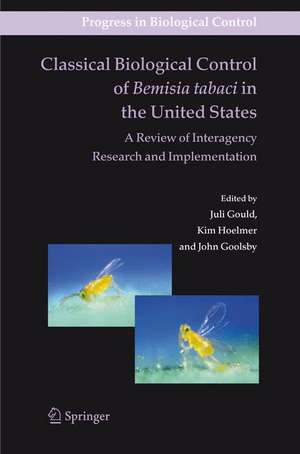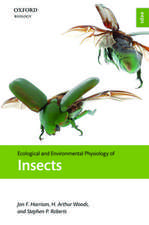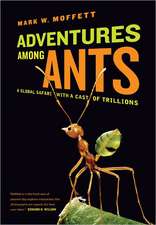Classical Biological Control of Bemisia tabaci in the United States - A Review of Interagency Research and Implementation: Progress in Biological Control, cartea 4
Editat de Juli Gould, Kim Hoelmer, John Goolsbyen Limba Engleză Hardback – 26 mar 2008
| Toate formatele și edițiile | Preț | Express |
|---|---|---|
| Paperback (1) | 643.65 lei 6-8 săpt. | |
| SPRINGER NETHERLANDS – 25 noi 2010 | 643.65 lei 6-8 săpt. | |
| Hardback (1) | 652.17 lei 6-8 săpt. | |
| SPRINGER NETHERLANDS – 26 mar 2008 | 652.17 lei 6-8 săpt. |
Din seria Progress in Biological Control
- 18%
 Preț: 952.57 lei
Preț: 952.57 lei - 18%
 Preț: 1222.01 lei
Preț: 1222.01 lei - 18%
 Preț: 1381.58 lei
Preț: 1381.58 lei - 18%
 Preț: 955.25 lei
Preț: 955.25 lei - 18%
 Preț: 956.33 lei
Preț: 956.33 lei - 15%
 Preț: 632.19 lei
Preț: 632.19 lei - 24%
 Preț: 1054.23 lei
Preț: 1054.23 lei - 15%
 Preț: 657.25 lei
Preț: 657.25 lei - 15%
 Preț: 649.06 lei
Preț: 649.06 lei - 18%
 Preț: 1412.20 lei
Preț: 1412.20 lei - 18%
 Preț: 942.76 lei
Preț: 942.76 lei - 24%
 Preț: 797.39 lei
Preț: 797.39 lei - 18%
 Preț: 1117.03 lei
Preț: 1117.03 lei - 18%
 Preț: 948.16 lei
Preț: 948.16 lei - 15%
 Preț: 653.14 lei
Preț: 653.14 lei - 18%
 Preț: 956.81 lei
Preț: 956.81 lei - 18%
 Preț: 1234.77 lei
Preț: 1234.77 lei - 18%
 Preț: 936.29 lei
Preț: 936.29 lei - 18%
 Preț: 1225.94 lei
Preț: 1225.94 lei
Preț: 652.17 lei
Preț vechi: 767.26 lei
-15% Nou
Puncte Express: 978
Preț estimativ în valută:
124.81€ • 135.52$ • 104.84£
124.81€ • 135.52$ • 104.84£
Carte tipărită la comandă
Livrare economică 22 aprilie-06 mai
Preluare comenzi: 021 569.72.76
Specificații
ISBN-13: 9781402067396
ISBN-10: 1402067399
Pagini: 300
Ilustrații: XVII, 343 p.
Dimensiuni: 155 x 235 x 20 mm
Greutate: 0.74 kg
Ediția:2008
Editura: SPRINGER NETHERLANDS
Colecția Springer
Seria Progress in Biological Control
Locul publicării:Dordrecht, Netherlands
ISBN-10: 1402067399
Pagini: 300
Ilustrații: XVII, 343 p.
Dimensiuni: 155 x 235 x 20 mm
Greutate: 0.74 kg
Ediția:2008
Editura: SPRINGER NETHERLANDS
Colecția Springer
Seria Progress in Biological Control
Locul publicării:Dordrecht, Netherlands
Public țintă
ResearchCuprins
Foreign Exploration for Insect Natural Enemies of Bemisia for Use in Biological Control in the USA: A Successful Program.- Entomopathogenic Fungi for Control of Bemisia tabaci Biotype B: Foreign Exploration, Research and Implementation.- Systematics and Biology of Encarsia.- The Genus Eretmocerus.- Molecular Characterization with RAPD-PCR: Application of Genetic Diagnostics to Biological Control of the Sweetpotato Whitefly.- Quarantine Evaluation of Parasitoids Imported into the USA for Biocontrol of Bemisia tabaci Biotype B.- Evaluation of Exotic Parasitoids and Predators in Field Cages in California.- Field Evaluation of Bemisia Parasitoids in Texas.- Mass-Rearing Bemisia Parasitoids for Support of Classical and Augmentative Biological Control Programs.- Release and Recovery of Exotic Parasitoids of Bemisia tabaci in the Lower Rio Grande Valley of Texas.- Release and Recovery of Four Species of Eretmocerus against Bemisia tabaci Biotype B in Arizona.- Release and Recovery of Exotic Natural Enemies of Bemisia tabaci (Biotype “B”) ((Hemiptera: Aleyrodidae) in Imperial Valley, California.- Releases of Exotic Parasitoids of Bemisia tabaci in San Joaquin Valley, California.- Habitat Management for the Establishment of Bemisia Natural Enemies.- Integrating Parasitoid Releases with Traditional Control Methodologies: Experience in the Spring Melon Production System in the Southwestern USA.- Multivariate Analysis of Bemisia tabaci Biotype B and Associated Parasitoid Populations within the Imperial Valley Agricultural System.- Indigenous Parasitoids of Bemisia in the USA and Potential for Non-Target Impacts of Exotic Parasitoid Introductions.
Notă biografică
Dr. Juli Gould received a bachelor of science in Natural Resources from Cornell University in 1982. She received a doctorate at the University of Massachusetts with a dissertation titled "Estimating the Impact of Parasitoids on the Dynamics of Populations of Gypsy Moths". Dr. Gould did post-doctoral research at the University of California at Riverside, where she was a member of the team that successfully controlled the ash whitefly with biological control. Dr. Gould joined USDA-APHIS in 1993 as the project leader for Russian wheat aphid biological control. In 1994, Dr. Gould moved to the Phoenix Plant Protection Center as project leader for biological control of the silverleaf whitefly. She also became project leader for biological control of saltcedar, an invasive, exotic weed. In 2001, Dr. Gould joined the Otis Survey, Detection and Exclusion Laboratory in Massachusetts. Her initial focus involved research on noctuid moths in the genus Copitarsia, with the goal of better assessing the risk posed by these species and developing better detection and interception strategies. Currently Dr. Gould is the lead scientist on biological control of the Emerald Ash Borer.
Dr. Kim Hoelmer studied biological control at the University of California in Berkeley, where he received his B.Sc., M.Sc. and Ph.D. degrees in entomology and studied behavioral ecology of natural enemies of whiteflies for his thesis research. He joined USDA in 1988 as an ARS research entomologist to study natural enemies of Bemisia tabaci in Orlando, FL, and subsequently served as an APHIS project leader of the Bemisia biocontrol implementation program in the Imperial Valley in Brawley, CA. Dr. Hoelmer transferred to the ARS European Biological Control Laboratory in Montpellier, France, in 1998 to conduct foreign exploration for natural enemies of mirid plant bugs, soybean aphid, wheat stem sawfly, and olive fruit fly. He is now with the ARS Beneficial Insect Introduction Research laboratory in Newark, DE, and continues to work on biological control of invasive insect pests such as soybean aphid and brown marmorated stinkbug. In addition to foreign exploration, the major focus of Dr. Hoelmer’s research has been the study of behavioral and ecological factors that influence the efficacy of predators and parasitoids, and the development of better and more predictable methods for introducing and establishing effective new natural enemies.
Dr. John Goolsby received his B.S. (1983) and Ph.D. (1994) from Texas A&M University in entomology. He is currently a Research Entomologist with the United States Department of Agriculture-Agricultural Research Service (USDA-ARS) for the Beneficial Insects Research Unit in Weslaco, Texas. He specializes on biological control of weeds and insect pests. His current research focuses on biological control of giant reed, Arundo donax, in the Rio Grande Basin. He is also investigating the agroecology of insects vectoring zebra chip, a disorder of chipping potatoes in Texas. Formerly, Dr. Goolsby was director of the USDA - Australian Biological Control Laboratory in Brisbane, Australia. His research in Australia focused on exploration for the Old World climbing fern, Lygodium microphyllum, which is native to Australia and an invasive weed in the Florida Everglades. Prior to his overseas posting he was an entomologist with USDA-APHIS in Mission, Texas and co-project leader of the silverleaf whitefly biological control program.
Dr. Kim Hoelmer studied biological control at the University of California in Berkeley, where he received his B.Sc., M.Sc. and Ph.D. degrees in entomology and studied behavioral ecology of natural enemies of whiteflies for his thesis research. He joined USDA in 1988 as an ARS research entomologist to study natural enemies of Bemisia tabaci in Orlando, FL, and subsequently served as an APHIS project leader of the Bemisia biocontrol implementation program in the Imperial Valley in Brawley, CA. Dr. Hoelmer transferred to the ARS European Biological Control Laboratory in Montpellier, France, in 1998 to conduct foreign exploration for natural enemies of mirid plant bugs, soybean aphid, wheat stem sawfly, and olive fruit fly. He is now with the ARS Beneficial Insect Introduction Research laboratory in Newark, DE, and continues to work on biological control of invasive insect pests such as soybean aphid and brown marmorated stinkbug. In addition to foreign exploration, the major focus of Dr. Hoelmer’s research has been the study of behavioral and ecological factors that influence the efficacy of predators and parasitoids, and the development of better and more predictable methods for introducing and establishing effective new natural enemies.
Dr. John Goolsby received his B.S. (1983) and Ph.D. (1994) from Texas A&M University in entomology. He is currently a Research Entomologist with the United States Department of Agriculture-Agricultural Research Service (USDA-ARS) for the Beneficial Insects Research Unit in Weslaco, Texas. He specializes on biological control of weeds and insect pests. His current research focuses on biological control of giant reed, Arundo donax, in the Rio Grande Basin. He is also investigating the agroecology of insects vectoring zebra chip, a disorder of chipping potatoes in Texas. Formerly, Dr. Goolsby was director of the USDA - Australian Biological Control Laboratory in Brisbane, Australia. His research in Australia focused on exploration for the Old World climbing fern, Lygodium microphyllum, which is native to Australia and an invasive weed in the Florida Everglades. Prior to his overseas posting he was an entomologist with USDA-APHIS in Mission, Texas and co-project leader of the silverleaf whitefly biological control program.
Textul de pe ultima copertă
This book reviews the interagency research and development effort on classical biological control in the USA from 1992-2002. The successful exploration, importation, screening, evaluation, rearing, and establishment of at least five exotic Bemisia. tabaci natural enemies in rapid response to the devastating infestations in the USA is a landmark in interagency cooperation and coordination of multiple disciplines. In this volume, the various authors present detailed reviews of natural enemy exploration, introduction, and evaluation efforts that will serve as a guide to support and encourage classical biological control inputs into other integrated pest management systems.
Caracteristici
Covers all key aspects of the classical biocontrol program Includes 18 chapters contributed by 28 USDA, state department of agriculture, and university scientists who participated in the project Organization and conduct of the project serves as a useful model for developing programs directed at biological control and whiteflies in other countries, as well as biocontrol programs for other pests Complements other works on Bemisia that deal much more broadly with a wide range of subject areas













